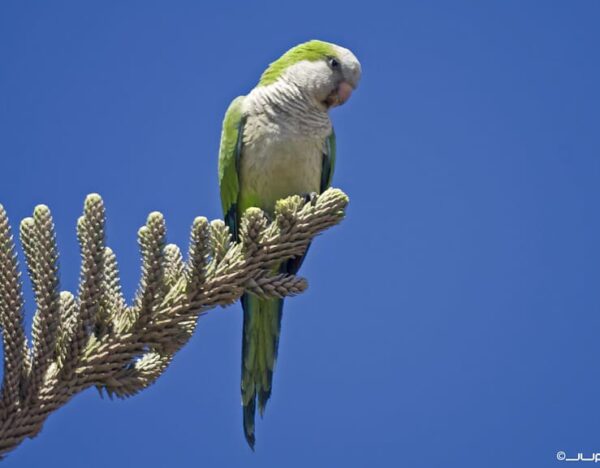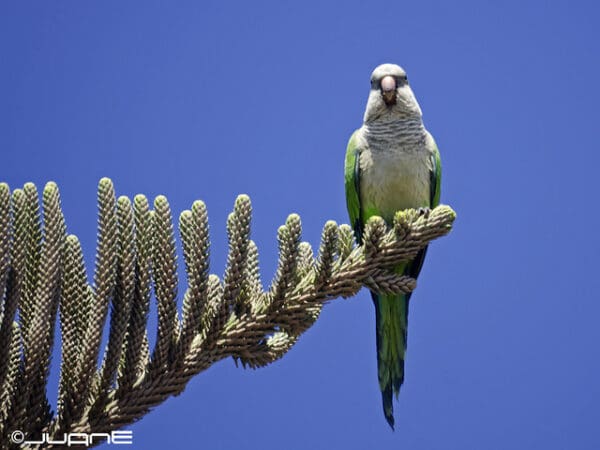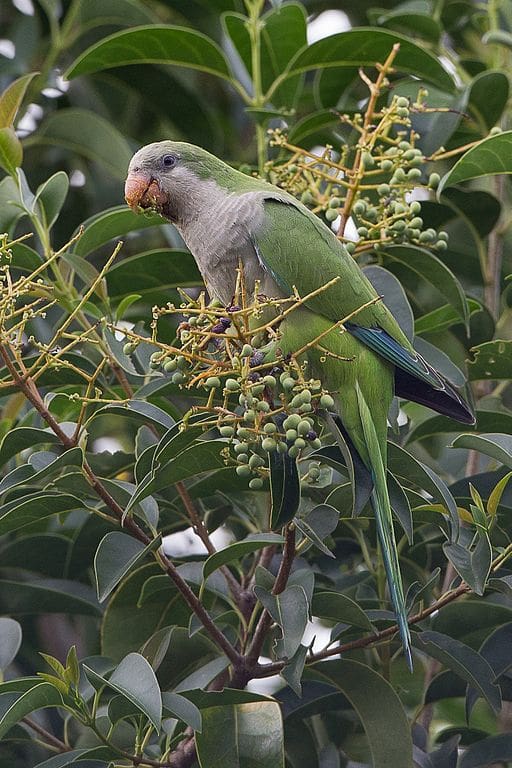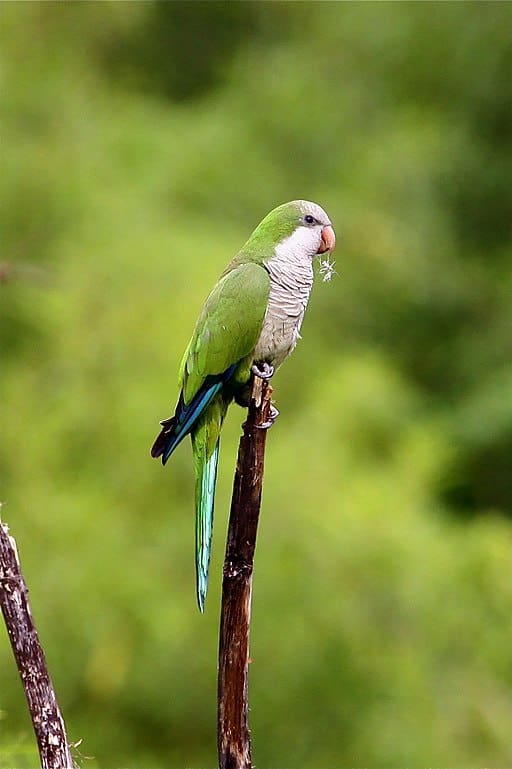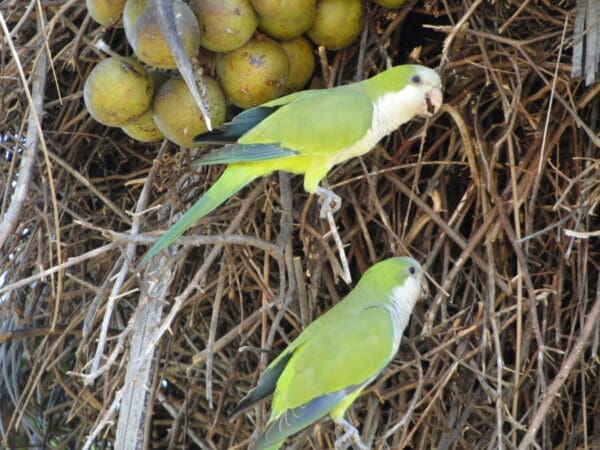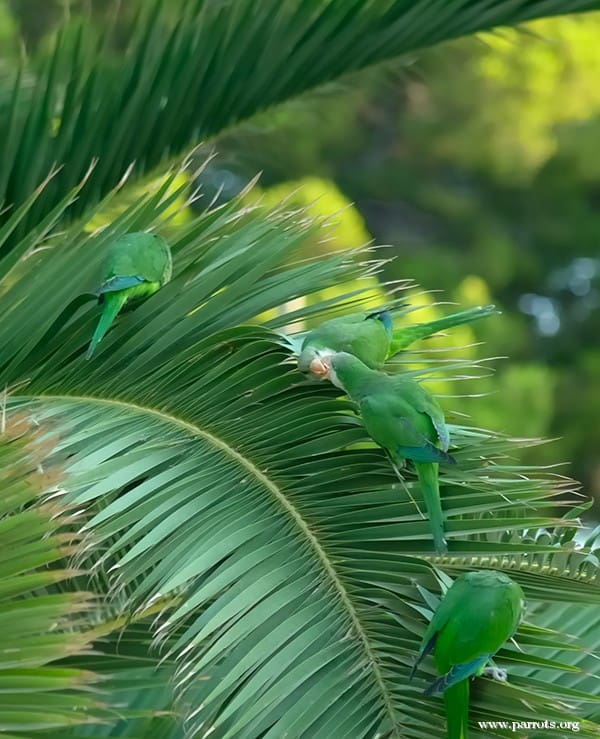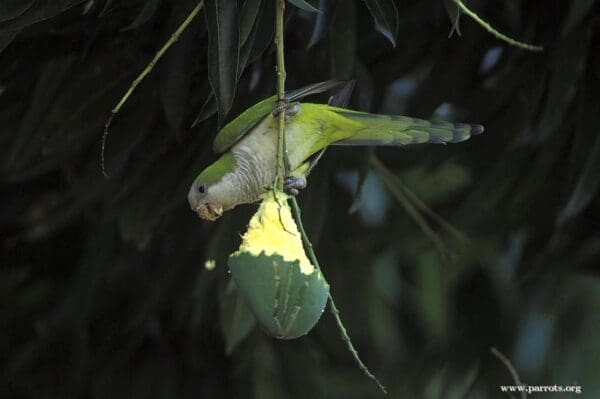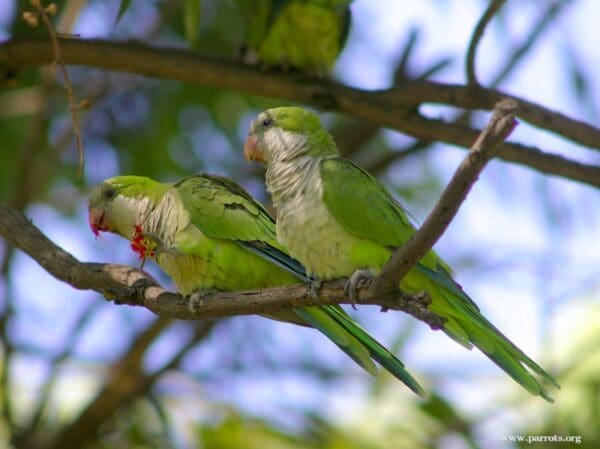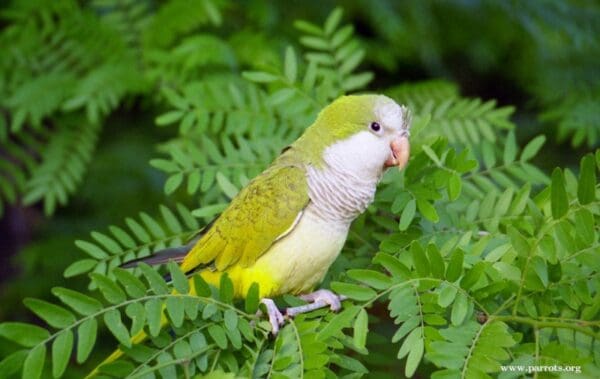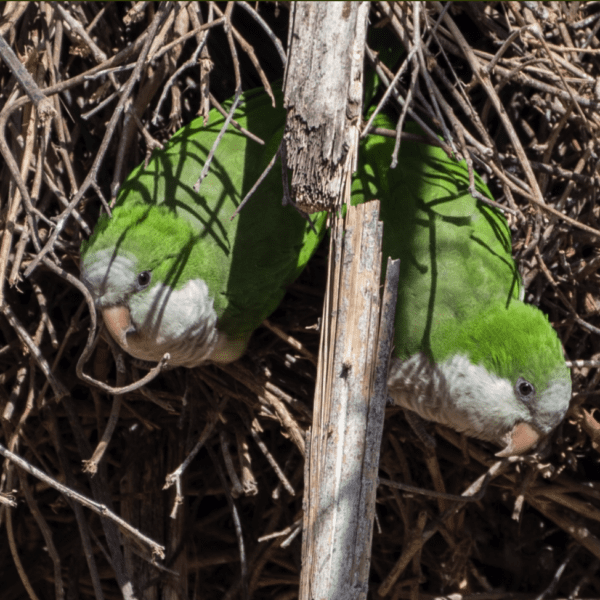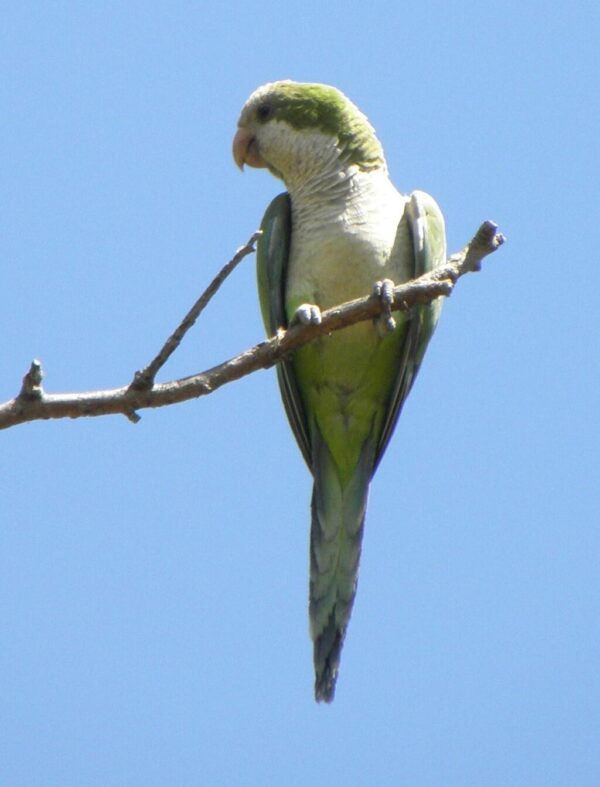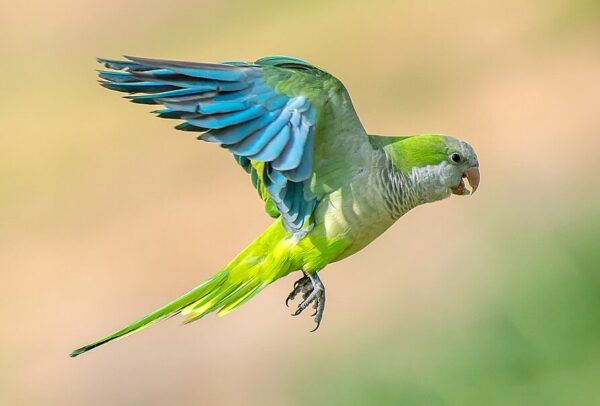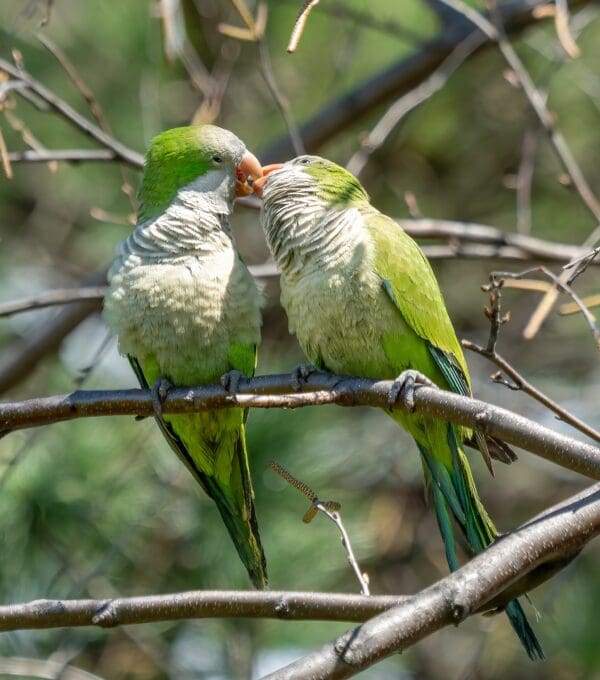Monk Parakeet
Also known as:
Quaker Parrot or Parakeet, Grey-breasted Parakeet
Also known as:
Quaker Parrot or Parakeet, Grey-breasted Parakeet
![© Juan Emilio [CC BY-NC 2.0] via Flickr A wild Monk Parakeet perches in a tree](https://parrots.org/wp-content/uploads/2023/01/Monk-Parakeet-e1736960975353-100x100.jpg)
![© Juan Emilio [CC BY-NC 2.0] via Flickr A wild Monk Parakeet perches on a branch](https://parrots.org/wp-content/uploads/2023/01/wpt_Monk-Parakeet_1218-13-100x100.jpg)
![© Nortondefeis [CC BY-SA 4.0] via Wikimedia Commons A wild Monk Parakeet feeds on berries](https://parrots.org/wp-content/uploads/2023/01/wpt_Monk-Parakeet_1218-10-100x100.jpg)
![© dfaulder (Monk Parakeet) [CC BY 2.0] via Wikimedia Commons A wild Monk Parakeet perches atop a branch](https://parrots.org/wp-content/uploads/2023/01/wpt_Monk-Parakeet_1218-9-100x100.jpg)
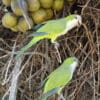

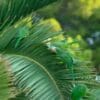
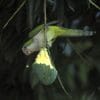
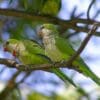
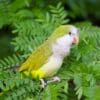
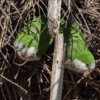
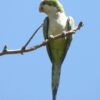
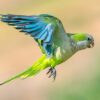

DID YOU KNOW?
The Monk Parakeet has established feral (non-native) populations in Alabama, Connecticut, Delaware, Florida, Illinois, Louisiana, New Jersey, New York, Oregon, Rhode Island, Texas and Puerto Rico, and the rest of the world in Bedfordshire and Alfreton, UK, and Holland, France, Italy, Belgium, Spain and the Canary Islands.

Myiopsitta

monachus
Size:
29 cm (11.3 in)
Weight:
127-140 g (4.4-4.9 oz)
Subspecies including nominate:
three: M.m. monachus, M.m. calita, M.m. cotorra
Colour Adult:
M.m. monachus: Both adults green in colour with yellow on underparts; forehead blue/grey turning to brown/grey on crown and back of head; face pale grey; breast brown/grey scalloped with grey/white; stripe across upper abdomen olive/yellow; underparts of wings (flight feathers) pale blue; upper tail green, undertail dull grey/blue at base. Beak orange/brown. Eye dark brown.
M.m. calita: Both adults head darker grey with no blue tint to forecrown; lower abdomen washed with blue; smaller size.
M.m. cotorra: Both adults as in calita, but upperparts brighter green in colour; abdomen less yellow.
Colour Juvenile:
As in adults but forehead grey tinted with green.
Call:
Produces wide array of shrill screeches, squawks and chatter while in flight or when feeding.
More Information:
Content Sources:
CITES
BirdLife International
Cornell Lab of Ornithology/Birds of the World
Parrots: A Guide to Parrots of the World, Juniper and Parr, 1998
Parrots of the World, Forshaw and Cooper, 1989. 2010 edition
Parrots of the World, Forshaw, 2006.
Parrots in Aviculture, Low, 1992.
Captive Status:
Common
Longevity:
25 yrs
Housing:
Aviary or suspended enclosure, minimum length 3 m (9.8 ft).
Diet:
Fruit such as: apple, pear, orange, cactus fruits, pomegranate, etc, forming about 30 percent of the diet; vegetables such as: carrot, celery, green beans and peas, corn; green leaves such as: Swiss chard, lettuce, sowthistle, dandelion, chickweed; spray millet; small seed mixture: canary, millet, safflower and limited sunflower seed; cooked beans or pulses and complete pellet.
Enrichment:
Socialization, bathing; provide nest building materials, puzzle toys, bird safe chewables (fir, pine, elder, willow, sterilized pine cones, vegetable tanned leather).
Nest Box Size:
This species nests in colonies. Provide a welded mesh base and a large supply of twigs, from which the pairs will build their nests. Nest boxes may be used (vertical box, 12″ x 12″ x 18″ (30.5 cm x 30.5 cm x 46 cm).
Clutch Size:
5-7
Fledging Age:
6-7 weeks
Hatch Weight:
—
Peak Weight:
—
Weaning Weight:
—
World Population:
Unknown but reported as common. Increasing.
IUCN Red List Status:
Least Concern
CITES Listing:
Appendix II
Threat Summary:
Evidence of population increase however since 1981, 710,686 individuals have been traded on the international wild bird market.
Range:
M.m. monachus: S Rio Grande do Sul, SE Brazil, through Uruguay to NE Argentina, south to E Buenos Aires.
M.m. calita: W Argentina, from Salta and W Buenos Aires south to Rio Negro.
M.m. cotorra: S Mato Grosso, Brazil and E Bolivia through Paraguay to N Argentina, in Formosa, Chaco and Corrientes.
Habitat:
Found in dry wooded country or open country with trees including gallery forest, isolated clumps of trees, palm groves, woodlots, savanna and thorn scrub with cacti. Also found in cultivated areas. Feral in some urban areas. Up to 1000 m (3280 ft).
Wild Diet:
Diet includes wild and cultivated seeds, fruits and vegetable items such as grass seeds and grain, cactus stems, root vegetables and tree fruits. Also includes insects and their larvae in its diet.
Ecology and Behaviour:
Occurs in pairs or flocks of 30-50 birds, with larger groups outside of breeding season. Roost communally, sleeping sometimes in nest outside of breeding season. Feeds in trees and on the ground, mixing with other species of birds such as pigeons and cowbirds.
Clutch and Egg Size:
5-7 ovate eggs, 28.0 x 21.5 mm (1.1 x 0.8 in).
Breeding Season:
October-December. Nest is in domed twig structure with as many as 20 other pairs.
Related Links:
—
